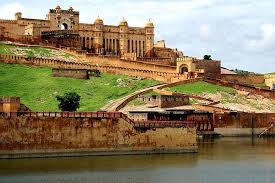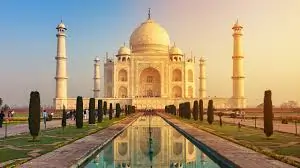Amer Fort and City Palace in Jaipur are two of Rajasthan’s most celebrated historical landmarks, each reflecting the opulence and power of the Rajput kingdom through their distinct architectural styles and cultural richness.
ADVERTIDEMENT

Table of Contents

Amer Fort and City Palace
Amer Fort, also known as Amber Fort, is a historic fortress located 11 kilometers from Jaipur, Rajasthan. Initially constructed in 1592 by Raja Man Singh I, a trusted general of the Mughal Emperor Akbar and an influential Rajput ruler of the Kachwaha clan, Amer Fort was the political center and royal residence of the Rajput kings. The fort’s history extends even further back to the town of Amer, originally established by the Meena tribe before the Kachwahas took control in the 10th century.
Under Raja Man Singh’s leadership, Amer Fort was expanded into a grand structure that blended Rajput and Mughal architectural influences, symbolizing the alliance between the Rajputs and Mughals during this period. Successive rulers, including Mirza Raja Jai Singh I, continued to enhance the fort, adding the Sheesh Mahal (Mirror Palace) and other decorative elements that reflected Rajput artistry. Despite its strategic hilltop location and formidable defenses, Amer Fort also embodied opulent architecture that served the dual purposes of defense and royal luxury.
In 1727, Maharaja Sawai Jai Singh II founded Jaipur, relocating the capital from Amer to his newly designed city. Sawai Jai Singh II, a visionary ruler, astronomer, and planner, established Jaipur as India’s first planned city, designed in accordance with the ancient architectural texts of Vastu Shastra and Shilpa Shastra.
To achieve his vision, he invited Vidyadhar Bhattacharya, a renowned architect from Bengal, to assist in designing Jaipur’s city layout, with City Palace as its central landmark. Completed shortly after the city’s founding, City Palace became the royal residence and administrative hub, marking Jaipur’s status as a new power center.
With its unique blend of Rajput, Mughal, and European architectural elements, the City Palace reflects Jaipur’s cosmopolitan identity and the cultural openness of its rulers. Over time, successive Maharajas expanded the City Palace complex, adding structures such as the Mubarak Mahal and Chandra Mahal, both of which embodied the artistic tastes and royal grandeur of Jaipur’s elite.
I. Introduction
Overview of Amer Fort and City Palace in Jaipur
Introduction to Amer Fort and City Palace as iconic landmarks representing the rich heritage of Rajasthan. Mention their significance in showcasing Rajputana grandeur, architectural brilliance, and historical depth.
Their Role in Tourism and Cultural Representation
Both Amer Fort and City Palace are among Jaipur’s most visited sites, drawing tourists from around the world. Highlight their roles as windows into Rajasthan’s royal past and their contribution to Jaipur’s identity as a historic city of forts and palaces.
II. Amer Fort
Location and Historical Context
Geographic Setting: Located on a hillside overlooking Maota Lake, about 11 km from Jaipur, providing both a scenic and strategic view.
Historical Background: Built in 1592 by Raja Man Singh I, a trusted general of the Mughal Emperor Akbar.
Expansion and Fortification: Successive Rajput rulers expanded Amer Fort, adding features that combined both aesthetics and military functionality.
Role as a Royal Residence and Military Stronghold: Amer Fort served as the primary residence for Rajput rulers and a protective fortress defending the kingdom from invaders.
Architectural Fusion of Rajput and Mughal Styles
The fort’s architecture blends Hindu and Mughal styles, incorporating local Rajput elements with Mughal decorative details, resulting in a unique aesthetic.
Key Structures within Amer Fort:
Ganesh Pol: A grand gateway adorned with elaborate paintings and carvings, leading to the fort’s private palaces and symbolizing protection.
Sheesh Mahal (Mirror Palace): A hall of mirrors and glass mosaics designed to illuminate with minimal light, showcasing the artistry of mirror inlay work.
Diwan-i-Aam (Hall of Public Audience): A spacious hall with intricately carved columns where the king held public hearings and addressed grievances.
Diwan-i-Khas (Hall of Private Audience): Reserved for meetings with high-ranking officials and dignitaries, showcasing finely detailed frescoes and arches.
Sukh Niwas (Hall of Pleasure): Ingeniously designed with water channels that naturally cool the room, reflecting Rajput engineering solutions to Jaipur’s heat.
Architectural Significance and Preservation
The structure combines beauty with defensive architecture, featuring walls, gates, and courtyards that demonstrate the strategic mind of Rajputana design. Amer Fort’s status as part of the UNESCO-listed “Hill Forts of Rajasthan,” emphasizing the importance of preserving its historical and architectural integrity.
Cultural Significance and Legacy
Amer Fort’s role as a cultural representation of the Rajput kingdom, highlighting the royal family’s lifestyle, customs, and engineering skills. Ongoing preservation efforts to ensure the fort remains a cultural and historical icon, allowing visitors to experience the legacy of the Rajput rulers.
III. City Palace
Location and Historical Background
- Situated in Jaipur’s Old City: City Palace is centrally located, blending seamlessly with the city’s historic surroundings.
- Founded by Maharaja Sawai Jai Singh II in 1727: The same year Jaipur was established as a planned city.
- Purpose and Function: Built as a royal residence and administrative hub, the City Palace served as a ceremonial and political center for Jaipur’s rulers.
- Continuous Royal Occupancy: Parts of the palace still serve as the residence of Jaipur’s royal family, bridging historical tradition with modern-day presence.
- Architectural Highlights and Key Structures
- Architectural Fusion of Rajput, Mughal, and European Styles
- The palace features Indo-Saracenic elements with Rajput and Mughal architecture, enhanced by European motifs, showcasing Jaipur’s cosmopolitan influence.
- Key Structures within City Palace:
- Mubarak Mahal: Built as a reception hall with Indo-Islamic architecture, this structure now houses a museum displaying royal costumes, textiles, and other artifacts.
- Chandra Mahal: The seven-story main palace building, featuring unique frescoes and decorations on each floor, with some floors still used by the royal family.
- Pritam Niwas Chowk: The inner courtyard with four seasonal gates, each gate decorated with intricate motifs representing the four seasons (Peacock Gate for autumn, Lotus Gate for summer, Green Gate for spring, and Rose Gate for winter).
- Peacock Gate: Decorated with vibrant peacock mosaics, this gate is celebrated for its artistic detail and symbolic representation of prosperity and beauty.
- Museums and Galleries
- City Palace houses several museums and galleries showcasing royal artifacts, armory, manuscripts, and art collections, providing a rich cultural experience for visitors.
- Cultural and Historical Importance
- City Palace served as a political and cultural hub, where rulers hosted foreign dignitaries and conducted state affairs.
- The palace represents Jaipur’s royal legacy, with its museums offering insight into the luxurious lifestyles, clothing, art, and weaponry of Rajasthan’s royals.
IV. Symbolism and Cultural Influence
Representation of Rajput Royalty
- Amer Fort and City Palace stand as symbols of Rajput bravery, cultural sophistication, and architectural innovation.
- Their features—such as the Sheesh Mahal’s reflective mosaics and the Peacock Gate’s vibrant motifs—demonstrate the artistic values of the Rajput kings and queens.
- Tourism and Educational Significance
- Both sites attract tourists, history enthusiasts, and students of architecture, eager to learn about Rajasthan’s heritage.
- They provide educational insight into the region’s traditions, with exhibits and tours sharing the history of the Rajputana Empire and Jaipur’s evolution as a royal city.
V. Modern-Day Attraction and Visitor Experience
Guided Tours and Cultural Events
- Availability of guided tours offering in-depth knowledge about the historical background, architectural details, and symbolic aspects of the sites.
- Evening light and sound shows at Amer Fort, narrating the fort’s history and bringing its past to life in a memorable experience for visitors.
- Cultural performances like traditional music and dance at City Palace, offering a glimpse into the local arts and customs.
- Preservation Efforts and Public Access
- Ongoing conservation efforts by the government and heritage organizations to protect these monuments from environmental degradation and preserve their historical accuracy.
- Sections of both Amer Fort and City Palace open to the public, allowing access to key areas and museums while preserving private quarters still in use by the royal family.
- Museums within City Palace displaying artifacts, royal costumes, weaponry, and art, enhancing the visitor experience and offering an educational journey through Jaipur’s royal history.
Disclaimer
The information provided here about Amer Fort and City Palace is intended for general informational purposes. While every effort has been made to ensure accuracy, historical details and architectural descriptions may vary based on new research or local interpretations.
Visitors are encouraged to verify information and check with official sources or local guides when planning a visit. This content does not replace professional travel advice, and experiences may differ based on seasonal factors, cultural events, or conservation activities.
VI. Conclusion
Amer Fort and City Palace are not just architectural marvels but enduring symbols of Rajasthan’s rich royal heritage and cultural legacy. These iconic landmarks capture the grandeur, artistry, and historical depth of Jaipur’s past, showcasing the powerful legacy of the Rajput rulers.
Amer Fort, with its defensive strength and artistic opulence, and City Palace, with its blend of traditions and cosmopolitan influences, both offer unique glimpses into the royal lifestyles and architectural advancements of the Rajput era. Together, they stand as treasured monuments that continue to educate, inspire, and captivate visitors from around the world, preserving the stories and splendor of Rajasthan’s royal history for generations to come.

